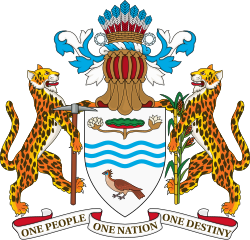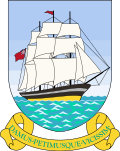
The coat of arms of the Bahamas contains a shield with the national symbols as its focal point.

The coat of arms of Barbados was adopted on 14 February 1966, by a royal warrant of Queen Elizabeth II. The coat of arms of Barbados was presented by the Queen to the then President of the Senate of Barbados, Sir Grey Massiah. Like other former British possessions in the Caribbean, the coat of arms has a helmet with a national symbol on top, and a shield beneath that is supported by two animals.
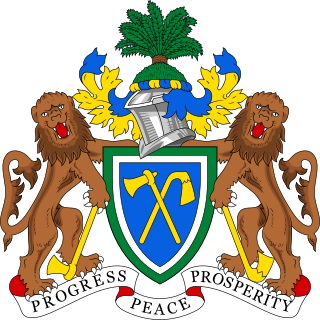
The coat of arms of The Gambia has been in use since 18 November 1964. It depicts two lions holding an axe and hoe, supporting a shield that depicts another pair of hoe and axe, crossed. Atop the shield is set the heraldic helmet and an oil palm as a crest. At the bottom is the national motto: Progress – Peace – Prosperity. The Gambian coat of arms also appeared in the fly of the Gambian air force ensign.
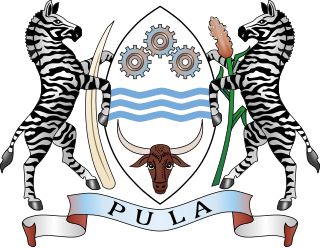
The coat of arms of Botswana was adopted on 25 January 1966. The centre shield is supported by two zebras. The shape of the shield is that of traditional shields found in Southern Africa. On the top portion of the shield are three cogwheels that represent industry.
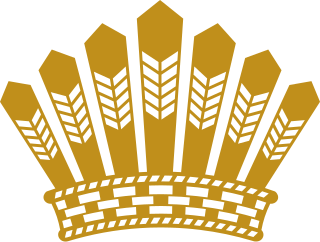
The president of Guyana is the head of state and the head of government of Guyana, as well as the commander-in-chief of the armed forces of the Republic, according to the Constitution of Guyana. The president is also the chancellor of the Orders of Guyana. Concurrent with their constitutional role as Commander-in-Chief of the Armed Forces, the president does not appoint a separate Minister of Defence. That portfolio is held by the president who fulfils all responsibilities designated to a minister of defence under the Defence Act.
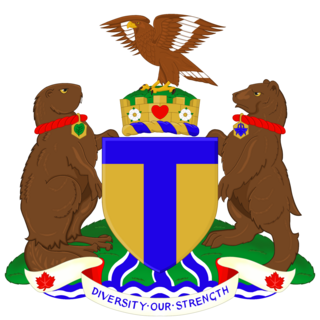
The coat of arms of Toronto is a heraldic symbol used to represent the city Toronto. Designed by Robert Watt, the Chief Herald of Canada at the time, for the City of Toronto after its amalgamation in 1998. The arms were granted by the Canadian Heraldic Authority on 11 January 1999.
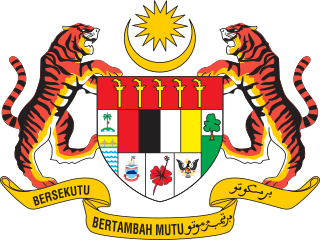
The coat of arms of Malaysia is a coat of arms comprising a shield or escutcheon, two tigers for supporters, a crescent and fourteen-pointed star for a crest and a motto. As the Malaysian coat of arms descended from that of the Federated Malay States under British colonial rule, it resembles European heraldic designs.

The coat of arms of Zimbabwe was adopted on 21 September 1981, one year and five months after the national flag was adopted. Previously the coat of arms of Zimbabwe was identical to the former coat of arms of Rhodesia.
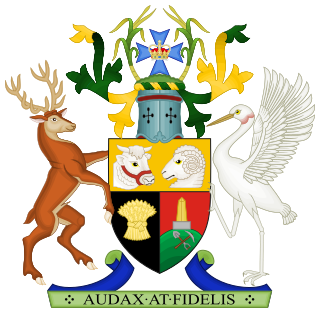
The coat of arms of Queensland is one of the formal symbols of the Australian state of Queensland and represents the King's constitutional authority throughout the state. It is the oldest of the state arms of Australia, having been granted in 1893 by Queen Victoria, through the simplest heraldic grants of only the shield of arms, motto, helmet, mantling and crest. In 1977, the red deer and the brolga were assigned as supporters by Queen Elizabeth II during her Silver Jubilee.

The coat of arms of Portugal is the main heraldic insignia of Portugal. The present model was officially adopted on 30 June 1911, along with the present model of the Flag of Portugal. It is based on the coat of arms used by the Kingdom of Portugal since the Middle Ages. The coat of arms of Portugal is popularly referred as the Quinas.

The coat of arms of Vancouver was granted by the College of Arms on 31 March 1969.

The flag of Vancouver was adopted by the Vancouver City Council on May 17, 1983. It was designed by Robert Watt, the director of the Vancouver Museum at the time, and later the Chief Herald of Canada. It features a white field with five wavy blue barrulets, and a green pentagon on the hoist side surmounted by a gold shield with the city badge, which consists of a mural crown with crossed axe and paddle.

The coat of arms of Hobart was formally granted to the Lord Mayor, Aldermen and Citizens of the City of Hobart in Tasmania on 1 May 1953.
The flag and the coat of arms of Negeri Sembilan are state symbols of Negeri Sembilan, Malaysia. The symbols are predominantly depicted in red, black and yellow, traditional colours of the Minangkabau people who are the original settlers in the present-day state. Also recognised in the symbols are the political history of Negeri Sembilan, its ruler, and the state's past relationship with the British Empire.

The coat of arms of the City of Christchurch, also known as the armorial bearings, is the official symbol of the City of Christchurch, New Zealand. They were granted to the city by the College of Arms by letters patent on 21 February 1949.
The Orders, decorations, and medals of Guyana were established after Guyana gained independence from the United Kingdom. In 1970 Guyana became a Republic and established its first two national awards under the Constitution of the Orders of Guyana. In 1976, the Constitution of the Orders of Guyana was amended to add a third national award.
National emblems of Barbados are the symbols that are used in Barbados to represent the independent nation. The emblems reflect different aspects of its cultural life and history.
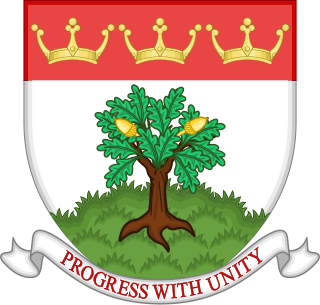
The coat of arms of the London Borough of Ealing is the official heraldic arms of the London Borough of Ealing, England, granted on 1 September 1965.
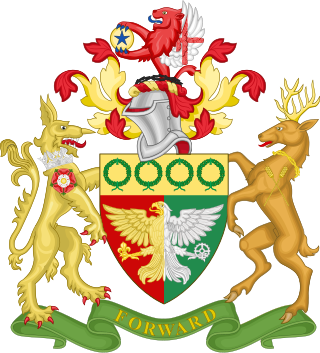
The coat of arms of the London Borough of Hillingdon is the official symbol of the London Borough of Hillingdon. They use elements from the coats of arms of the four previous districts. It is described as:
Arms: Per pale Gules and Vert an Eagle displayed per pale Or and Argent in the dexter claw a Fleur-de-lis Or and in the sinister claw a Cog-Wheel Argent on a Chief Or four Civic Crowns Vert.
Crest: On a Wreath of the Colours issuant from a Circlet of Brushwood Sable a demi-Lion Gules with wings Argent the underside of each wing charged with a Cross Gules and holding between the paws a Bezant thereon a Mullet Azure.
Supporters: On the dexter side an Heraldic Tiger Or gorged with an Astral Crown Azure and charged on the shoulder with a Rose Gules charged with another Argent barbed and seeded proper and on the sinister side a Stag proper attired and gorged with a Circlet of Brushwood and charged on the shoulder with two Ears of Rye slipped in saltire Or.
Motto: Forward.
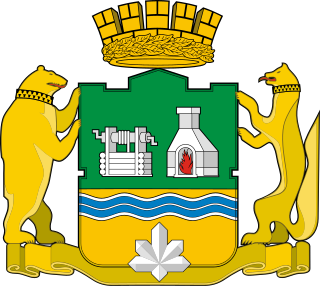
The coat of arms of Yekaterinburg is the official municipal coat of arms of Yekaterinburg, Russia. The current symbol was adopted on 23 May 2008 and consists of a French shield divided horizontally into two fields, with a white mine shaft and a white furnace within the top field, which is green, and a blue wavy bend within the bottom field, which is gold. A gold bear and gold sable are located to the left and right of the shield, respectively. A gold crown with a gold laurel wreath is located above the shield and a gold ribbon is located below the shield. A grey druse is located at the bottom center of the shield.
